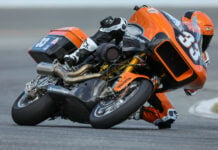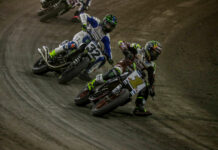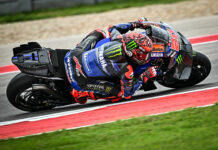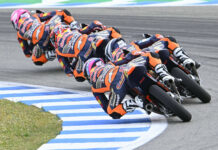From a press release:
Team Suzuki News Service
NEW TESTS PREPARE SUZUKI MEN FOR SECOND MICHELIN RACE
MotoGP – Round 4, Le Mans, France, 19th May 2002.
Team Telefónica MoviStar Suzuki riders Kenny Roberts Jr. and Sete Gibernau come to Le Mans with a few more miles under their newly shod wheels than after the last round in Spain.
That was the first race for the powerful new four-stroke GSV-R – Suzuki’s exciting new Blue Baritone – on Michelin tyres, after a switch from undeveloped Dunlop tyres to the established class-leading Michelins. Up against rivals who had been testing on those tyres since before the start of the season, it was like the first test.
The team stayed on at Jerez after the Spanish round, where they finished eighth and ninth, for two days of testing, the second spoiled by rain; and then travelled to Clermont Ferrand, to Michelin’s own track, for specially controlled tests in wet conditions.
Although still in the early stages of development, after only three months out of the workshop, the powerful new-generation Suzuki surprised even factory staff and team personnel with its ability. In the first round in Japan, it challenged for pole position, led the race, and finished a close second to defending champion Valentino Rossi. This competitive performance, from a machine already brought out a full year earlier than originally planned, triggered the decision to switch to ready-to-race tyres rather than continuing with the development programme.
After a troubled race in South Africa, the machines were reshod for the Spanish round with the familiar Michelins – used almost continuously by the team for more than 25 years. Two top-ten finishes confirmed the Blue Baritone’s early promise, but also proved what the team already knew: that switching tyres was in one sense almost like starting again, against rivals who had been working with the Michelins for several months.
The tests meant they could make some amends for the deficit, and to work towards finding a base set-up for the new combination. At the same time, the machine is undergoing rapid development, with a constant supply of new parts and ideas from the factory race department in Japan, working closely with the race team.
Team manager Garry Taylor was looking forward to arriving at the French circuit better-prepared than in Spain, where the team used the new tyres for the first time in the first practice session.
“That was like our first test, and though our aim is to be in a position to win races sooner rather than later, there were many reasons to be pleased with the machine’s qualifying performance, and two top-ten finishes,” he said.
“The extra tests have given us a chance to build on our race experience with the Michelins, and look for another step towards our ultimate goal with the new machine,” added Taylor. “The mood of the riders and the whole team is very positive.”
The Le Mans race is expected to draw bigger crowds than ever before, as French fans flock for their first chance to see the new MotoGP 990cc four-stroke machines like the Suzuki up against the established 500cc two-strokes.
At Jerez for the Spanish GP the technical track with few straights meant that the two-strokes were able to fight back, with five 500cc bikes in the top seven, although the race was won by defending champion Valentino Rossi’s four-stroke. Le Mans is a track with predominately slow corners linked by short “drag-strip” straights, which should hand the advantage back to the powerful new-generation MotoGP bikes.
The fourth of 16 rounds, the French GP is the second round in Europe, where the GP circus will stay, but for a side trip to Brazil, until late September, when four more “flyaway” GPs precede the final round at Valencia.
KENNY ROBERTS – TESTING TO IMPROVE
“Every test we do is beneficial – whether it goes well or badly. We’re finding things all the time that are going to make the bike better. At Jerez we found some aspects of the chassis that we need to address. As for the wet tests – I’ve always enjoyed riding in the rain, but our settings in Japan, where it rained only on race day, were something of a crap shoot. We’re going to Le Mans a lot more well rounded.”
SETE GIBERNAU – GETTING THERE STEP BY STEP
“I was really pleased to get back to familiar tyres to concentrate full on developing the bike and not tyres as well. We’re making progress all the time. My team and I got our heads together at the tests to keep the improvement going. We go racing to win, not for top-ten finishes, and not to talk about. We’ll keep working until we get there, and if we can maintain the rate of progress since we first started testing in January I’m confident we’ll get there soon.”
ABOUT THIS RACE
The French GP is a long-standing but irregular fixture on the calendar. The first event was run in 1951, the third year of GP racing – but in the 50 years since there have been just 37 events under that name. The race has wandered around the country, moving from the first event at Albi to Rouen, Reims, Clermont Ferrand, Le Castellet, Nogaro and Magny-Cours over the years. the first time at Le Mans was in 1969, on an early version of the then-new Bugatti circuit, which uses the traditional pits and start-finish area of the famous 24-hour track Since that time the circuit has been changed considerably in detail, even since the last series ended in 1995; while the French GP moved down south again to Le Castellet. The return to Le Mans in 2000 was forced when the Paul Ricard at Le Castellet was sold to Formula One mogul Bernie Ecclestone, and signalled something of a revival in attendance, with strong support at a track which has not always been able to count on big numbers of spectators.
ABOUT THIS TRACK
The Bugatti circuit originally used part of the famous Sarthe 24-hour car circuit – the pit straight and a daunting right-hand corner under the Dunlop bridge and down the hill – before looping off for the first of its U-turns and short straights. That corner has been made slower and safer, and a slow chicane put before the bridge, before rejoining the run downhill and hard onto the brakes for the first of several slow U-turns, linked with drag-strip straights, before the back straight leads to another twisting section and a slow corner to rejoin the start-finish straight. The U-turns are not uniform, however, and each has its own character and challenge. Another slight change for this year was dictated by an alteration to the long car circuit, and introduces a left-hand kink under braking for the first right-hand U-turn after the first downhill run. The lap record speed of less than 155 km/h puts Le Mans among the slower tracks on the calendar.
GP DATA
Bugatti Circuit – Le Mans
Circuit Length: 2.598 miles / 4.180 km
Lap Record: 1:39.594 – 96.344 mph / 155.051 km/h. M Biaggi (Yamaha) 2001 (Old Circuit)
2001 Race Winner: Max Biaggi (Yamaha)
2001 Race Average: 46:59.346 – 95.639 mph / 153.916 km/h.
2001 Fastest Race Lap: see lap record
2001 Pole Position: M Biaggi 1:38.421
2001 Kenny Roberts: Sixth, qualified Second (Telefónica MoviStar Suzuki)
2000 S Gibernau: Ninth, qualified 14th (Telefónica MoviStar Suzuki)
More From Suzuki MotoGP Team On Change To Michelin Tires
More From Suzuki MotoGP Team On Change To Michelin Tires
© 2002, Roadracing World Publishing, Inc.






